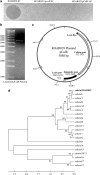A new biofilm-associated colicin with increased efficiency against biofilm bacteria
- PMID: 24451204
- PMCID: PMC4030232
- DOI: 10.1038/ismej.2013.238
A new biofilm-associated colicin with increased efficiency against biofilm bacteria
Abstract
Formation of bacterial biofilm communities leads to profound physiological modifications and increased physical and metabolic exchanges between bacteria. It was previously shown that bioactive molecules produced within the biofilm environment contribute to bacterial interactions. Here we describe new pore-forming colicin R, specifically produced in biofilms formed by the natural isolate Escherichia coli ROAR029 but that cannot be detected under planktonic culture conditions. We demonstrate that an increased SOS stress response within mature biofilms induces SOS-dependent colicin R expression. We provide evidence that colicin R displays increased activity against E. coli strains that have a reduced lipopolysaccharide length, such as the pathogenic enteroaggregative E. coli LF82 clinical isolate, therefore pointing to lipopolysaccharide size as an important determinant for resistance to colicins. We show that colicin R toxicity toward E. coli LF82 is increased under biofilm conditions compared with planktonic susceptibility and that release of colicin R confers a strong competitive advantage in mixed biofilms by rapidly outcompeting sensitive neighboring bacteria. This work identifies the first biofilm-associated colicin that preferentially targets biofilm bacteria. Furthermore, it indicates that the study of antagonistic molecules produced in biofilm and multispecies contexts could reveal unsuspected, ecologically relevant bacterial interactions influencing population dynamics in natural environments.
Figures







Similar articles
-
Screening of Escherichia coli species biodiversity reveals new biofilm-associated antiadhesion polysaccharides.mBio. 2011 May 10;2(3):e00043-11. doi: 10.1128/mBio.00043-11. Print 2011. mBio. 2011. PMID: 21558434 Free PMC article.
-
Activity of Species-specific Antibiotics Against Crohn's Disease-Associated Adherent-invasive Escherichia coli.Inflamm Bowel Dis. 2015 Oct;21(10):2372-82. doi: 10.1097/MIB.0000000000000488. Inflamm Bowel Dis. 2015. PMID: 26177305
-
Colicin E2 expression in Escherichia coli biofilms: Induction and regulation revisited.Curr Res Microb Sci. 2022 Nov 8;3:100171. doi: 10.1016/j.crmicr.2022.100171. eCollection 2022. Curr Res Microb Sci. 2022. PMID: 36518173 Free PMC article.
-
Translocation trumps receptor binding in colicin entry into Escherichia coli.Biochem Soc Trans. 2012 Dec 1;40(6):1443-8. doi: 10.1042/BST20120207. Biochem Soc Trans. 2012. PMID: 23176496 Review.
-
How bacteria protect themselves against channel-forming colicins.Int Microbiol. 2000 Jun;3(2):81-8. Int Microbiol. 2000. PMID: 11001536 Review.
Cited by
-
Shielding Effect of Escherichia coli O-Antigen Polysaccharide on J5-Induced Cross-Reactive Antibodies.mSphere. 2021 Jan 27;6(1):e01227-20. doi: 10.1128/mSphere.01227-20. mSphere. 2021. PMID: 33504665 Free PMC article.
-
Evaluation of Different Phenotypic Techniques for the Detection of Slime Produced by Bacteria Isolated from Clinical Specimens.Cureus. 2016 Feb 23;8(2):e505. doi: 10.7759/cureus.505. Cureus. 2016. PMID: 27026830 Free PMC article.
-
Bacteriocins in the Era of Antibiotic Resistance: Rising to the Challenge.Pharmaceutics. 2021 Feb 2;13(2):196. doi: 10.3390/pharmaceutics13020196. Pharmaceutics. 2021. PMID: 33540560 Free PMC article. Review.
-
Sensing of Escherichia coli and LPS by mammary epithelial cells is modulated by O-antigen chain and CD14.PLoS One. 2018 Aug 24;13(8):e0202664. doi: 10.1371/journal.pone.0202664. eCollection 2018. PLoS One. 2018. PMID: 30142177 Free PMC article.
-
Genomic diversity of Salmonella enterica serovar Typhimurium isolated from chicken processing facilities in New South Wales, Australia.Front Microbiol. 2024 Aug 14;15:1440777. doi: 10.3389/fmicb.2024.1440777. eCollection 2024. Front Microbiol. 2024. PMID: 39206360 Free PMC article.
References
-
- Bandara HM, Lam OL, Watt RM, Jin LJ, Samaranayake LP. Bacterial lipopolysaccharides variably modulate in vitro biofilm formation of Candida species. J Med Microbiol. 2010;59:1225–1234. - PubMed
Publication types
MeSH terms
Substances
LinkOut - more resources
Full Text Sources
Other Literature Sources
Medical

